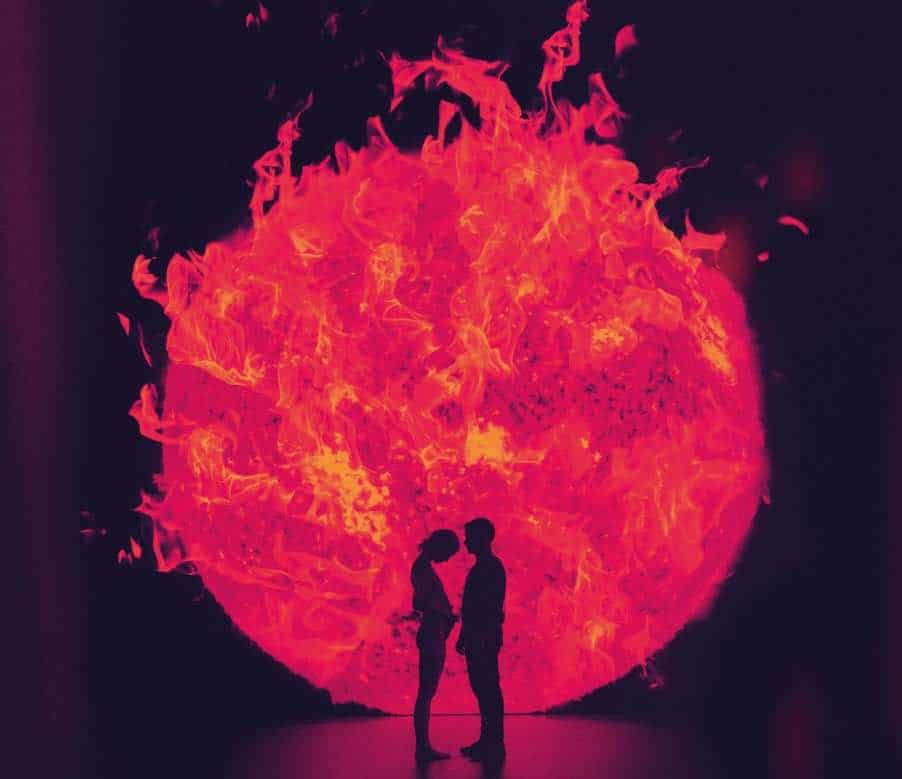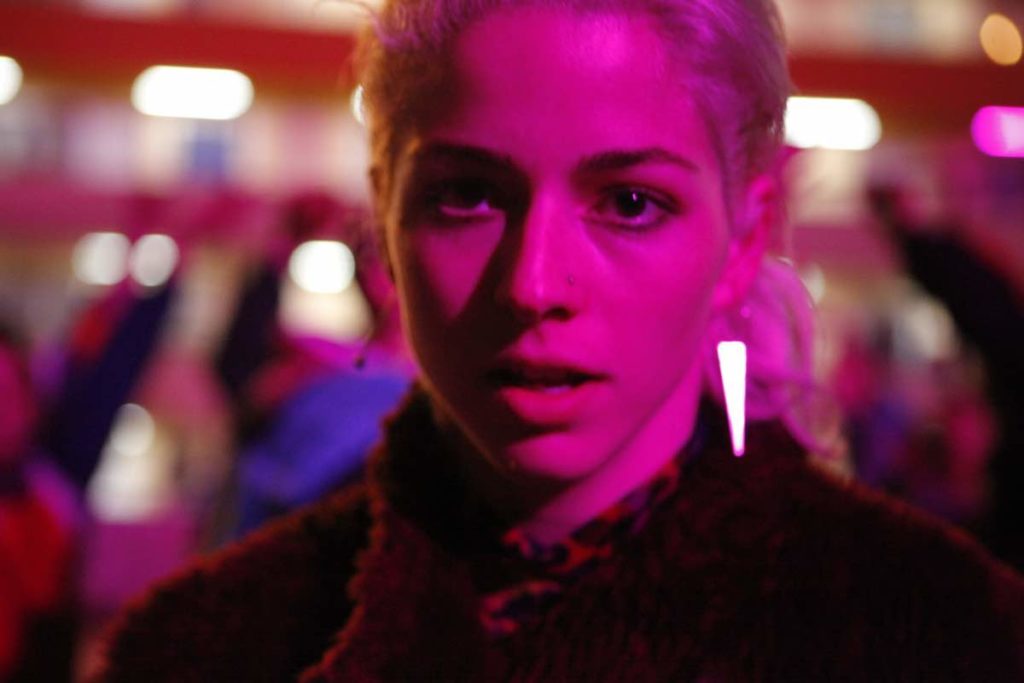Director Pablo Larraín and lead actress Mariana di Girolamo discuss their pulsing, colourful, bonkers, and utterly invigorating film, Ema, revealing character through dance, and creating a hypnotic central character.

Pablo Larraín’s Ema is a bizarre, colourful, pulsing, bonkers, and utterly invigorating cinematic experience. Part melodrama, part dance film, it defies categorization and even explanation: like dance itself, it has to be experienced to be understood. The film mixes the high emotions of Jackie with the looseness of The Club, and occasionally, the wry humour of Neruda. Ema deliberately embraces a kind of freedom in the way the film was written, made, and told, playing with both structure and your head.
Newcomer and stage actress Mariana di Girolamo stars as Ema, a woman who is equal parts captivating and terrifying. When we meet Ema, she is still reeling from the decision that she and her choreographer husband, Gastón (Gael García Bernal), made to return their adoptive son to care after he burned Ema’s sister’s face. She feels she’s made a mistake, and she’s chasing down her case worker for details about her son’s whereabouts. That obsession will fuel much of her erratic and often downright psychotic behaviour. Struggling with her marriage, she leaves Gastón and his world of contemporary dance to embark on a city-wide exploration of reggaeton, as well as a number of sexual affairs. Also, she roams the city with a flamethrower, setting things on fire — and there’s a question of whether she encouraged her son’s psychopathic tendencies.
The plot borders on the absurd, and doesn’t always work, and yet the film is hypnotic, with Nicolas Jaar’s score played loudly under almost every scene to intensify the heightened emotions. It’s also frequently very funny. When Ema tries to get a job teaching schoolchildren, the principal talks about children’s “expressive spines”; Bernal performs a diatribe against reggaeton where Gastón concludes that if you’re dancing to reggaeton, you might as well just give up, move to LA, and take selfies. Throughout, we feel like we’re witnessing a Greek tragedy in its emotional intensity, though all the moving pieces don’t come together until the final, hilarious act, in which everything is revealed, and the characters are as flabbergasted by Ema as we are.
The film is less psychological than it is about Ema’s almost mysterious gravitational pull, the way she draws people into her orbit and traps them there almost imperceptibly. Larraín often choreographs the way people are drawn to Ema in ways that mirror the dance in the film — especially the opening number by Jose Luís Vidal, in which a group of dancers are drawn inwards, into each other, and around the pulsing star that is projected as a backdrop. The scene where Ema seduces a female lawyer, in an erotic dance-turned-orgy, frequently calls back to this early dance number in the way the dancers encircle and entrap the lawyer.
After the film’s North American premiere at TIFF, I talked to director Pablo Larraín and lead actress Mariana di Girolamo about crafting Ema, a weird and mesmerizing film, and creating and shooting the film’s many dance numbers.
Seventh Row (7R): I understand you had an outline for Ema, but wrote the script as you were actually making it. What did the outline look like?
Pablo Larraín: We had all the scenes that we wanted to shoot, or most of them, organized in a time structure. A few of them had a specific description, and very few of them already had some dialogue. During the process of [shooting] the movie — Guillermo [Calderón] wrote most of the dialogue, and [co-writer] Alejandro [Moreno] and I were more of the structure — we were [coming to] understand what the movie was like and what were the relationships. It was a very particular process because we didn’t share the scenes with the actors. They had an idea of the outline that I had verbally told to them. They didn’t really know where the movie was going. They had an idea, but no detail. We would give the scenes one day, or two days before, and sometimes, in the morning of the same day we shot it.
Mariana Di Girolamo: [We learned our lines during] the makeup process.
Pablo Larraín: It was intentional, obviously. It means that they can’t really control their character. They’re more exposed to the process. They’re discovering it with you. They’re fragile. That delivers a very particular type of performance that is fresh and unique.
Mariana Di Girolamo: It was an act of freedom. Of course, it also meant that we were a little scared of what was happening. But that was not important because the background story was not important: where you came from or where you were going to was not as relevant as what was happening now and here in this moment.
7R: Pablo, had you worked this way before?
Pablo Larraín: With just one movie, The Club. It felt right for this specific movie [Ema]. To do this, you need to be in a production system that allows you to do that. It’s very unusual, from the financials to the actors. I was probably lucky to have them trust me.
7R: Can you tell me about the setting of Ema? What made you decide to shoot in Valparaiso, and how did you decide to capture the city?
Pablo Larraín: Valparaiso is a very particular city. It’s very labyrinthine. It’s full of hills. Once you’re near the ocean, everything is simple and exposed. Once you’re in the hills, you could be lost in a minute. It’s somehow a very complex place, next to an open place like the ocean: it shares that duality of openness and something that is very twisted and dark and hard to understand.
It’s a beautiful city that was built by immigrants over different periods. It has a lot of touristic, colourful places, and others that are very punk and trashed. We decided that instead of having one look to the city which might be more hygienic or pretty or to go just to the pretty part, we used it all. We said, “We’re going to observe and embrace the city, and take the best we can from it.”
The city is entirely covered, 90% of the walls have tags or graffiti. We understood that people are leaving a trace or a testimony in those walls. We were like, “What would our testimony, our trace look like?” That’s where we found the fire and the flamethrower. It’s an act of anarchism and beauty, to leave your own trace in the city. It’s linked to the way I see the characters.
Mariana Di Girolamo: It also reflects the mood or the character of Ema. She’s very hypnotic, like the fire, but very dangerous, in a certain way. You want to be close to her, but also very far away. Like Pablo said, she’s like the sun. Everyone is orbiting around her.
7R: There are a lot of dance numbers in Ema. What was the process for creating and shooting them?
Mariana Di Girolamo: I don’t know why you [Pablo] wanted to do dance in the first place. Pablo decided to start working with one very renowned choreographer, Jose Luis Vidal. We used one of his pre-existing pieces, Rito de Primavera. We used the choreography. Ema and her friends learn this choreography. After, Ema and her friends decide to move away from contemporary dance, from this plastic dance, and start moving towards reggaeton.
For the reggaeton part, we started working with another choreographer. That was more of a short process. It only took a month and a half or two months. That was a very important group for us. They were very generous, very open with their art, and I am very thankful to them.
Pablo Larraín: I was once at a party, and someone was filming me. I was not aware of the camera, and then I saw myself dancing. I was so ridiculous, but then there’s an element of myself, that comes from me, when I dance. Dancing can really express or say something about someone, about a character.
We thought to have her as a dancer would bring a different layer to the movie and to the character. It’s something she actually says when she’s trying to get hired. She says that children are always expressing themselves, when they move, when they dance, they play, when they say things. It’s pretty much the same for us. It’s like having another tool to build the character, to see the way she moves, which music, which circumstances, and that delivers something that you can’t really talk about. You have to see it.
Mariana Di Girolamo: She is an artist, a full artist.

7R: When you’re shooting those dance sequences in Ema, there’s a dance between the camera and the dancers. How did you approach this?
Pablo Larraín: It’s hard because you don’t want to make a music video. You don’t want to make a musical, choreography thing. It has to be something unique and explosive. So I worked really hard. It’s about framing. It’s about speed. It’s about rhythm and how are they actually moving, and obviously, the music, which delivers the beats. And also, how to use it and when in the movie. Try different places. We were rid of it, and then at some point, we left [in] that sequence of reggaeton where they dance around the city. It flirts with the musical, the music video world in the way that it’s about the state of the character. [The dance] has a dramatic use. It’s not only aesthetics. It’s just the flow of the rhythm, and ultimately, the flow of reggaeton.
Mariana Di Girolamo: It was a learning process. It was learning from Pablo, learning from the actors, failing, and then having to do it again. It was a matter of having to observe the camera, because it is Ema’s eyes.

7R: How did you design your shots of the dances?
Pablo Larraín: It’s in the physicality of how you actually do it. We did use wide angles and very close to her, and anamorphic [lenses]. What is good about wide angles and anamorphic is that you can actually see her well, and be with her, and at the same time, having the environment be part of it, in a way that is bright and organic and feels good.
Mariana Di Girolamo: For me, understanding how to do it was complicated. It was the first time that I was working with a Steadicam. It was about understanding the dialogue [with the camera]. You have to learn the distance. You have to have the timing. That can be pretty challenging, but it is very relevant.
Pablo Larraín: Steadicam is a crazy tool. It’s in motion. It’s a device that’s created to be in motion. It can do a lot of different things. The good thing is when you can actually move the camera and do it in the way that the audience doesn’t feel it. It’s kind of a ghost that’s tracking the actors. That can deliver many shots. At the beginning, Mariana had no experience with cinema. She didn’t really know how to relate to the camera. Eventually, she did, and it becomes a dance with the camera, as well. She understood that she would have to dance for the logic of the framing. It’s like a choreography made with the actors and the camera.
7R: What was your approach to the sound design in Ema?
Pablo Larraín: Roberto Espinoza is such a brilliant sound designer We worked really hard to bring the right atmosphere. Sound does a lot of work in the process. It’s strange because it’s designed to vanish, and to disappear somehow. But at the same time, it’s one of the strongest tools that you have to create an atmosphere and a tone. It’s very sensitive and sensorial. But it’s just pushing the tone and the atmosphere: Where are you? What’s close to you? How does that sound? Why? It’s a process that’s like a ghost. It’s behind the characters. It’s always there and defines your emotional connection with the scenes.
7R: The structure in your films is always so intricate and important. How much did the structure change and develop as you were making Ema and in the editing process?
Pablo Larraín: The structure was complicated in the beginning. When we cut it, it was way more complicated. We realised we had gone too far. So we went a few steps back and just simplified the structure as much as possible, even though it’s not that easy. The movie has its own voice, and that works. [Editor] Felipe [Inostroza] and I worked very hard on it. It was a long process. We tried a number of things. In the end, we went back to a very simple structure of three acts. If you look at it, it’s a very simple structure. It’s just the way that it’s told might not be that simple.
It’s about building something that is very internal. Sometimes, it works because it just feels good. I don’t have an intellectual explanation for every moment. A lot of it just came from experiencing it.

